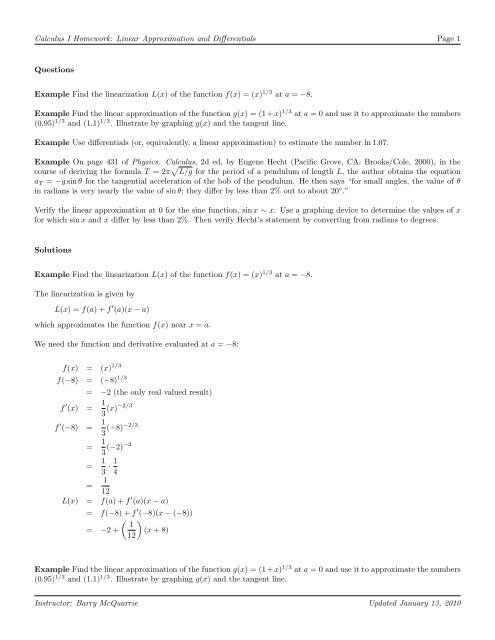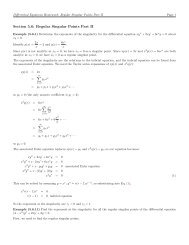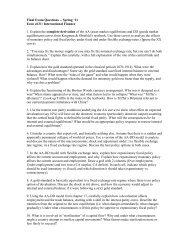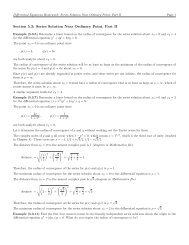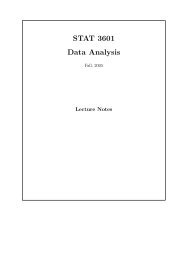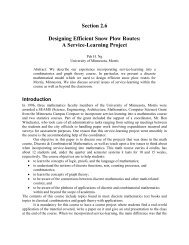Calculus I Homework: Linear Approximation and Differentials Page 1
Calculus I Homework: Linear Approximation and Differentials Page 1
Calculus I Homework: Linear Approximation and Differentials Page 1
You also want an ePaper? Increase the reach of your titles
YUMPU automatically turns print PDFs into web optimized ePapers that Google loves.
<strong>Calculus</strong> I <strong>Homework</strong>: <strong>Linear</strong> <strong>Approximation</strong> <strong>and</strong> <strong>Differentials</strong> <strong>Page</strong> 1<br />
Questions<br />
Example Find the linearization L(x) of the function f(x) = (x) 1/3 at a = −8.<br />
Example Find the linear approximation of the function g(x) = (1 + x) 1/3 at a = 0 <strong>and</strong> use it to approximate the numbers<br />
(0.95) 1/3 <strong>and</strong> (1.1) 1/3 . Illustrate by graphing g(x) <strong>and</strong> the tangent line.<br />
Example Use differentials (or, equivalently, a linear approximation) to estimate the number ln 1.07.<br />
Example On page 431 of Physics: <strong>Calculus</strong>, 2d ed, by Eugene Hecht (Pacific Grove, CA: Brooks/Cole, 2000), in the<br />
course of deriving the formula T = 2π � L/g for the period of a pendulum of length L, the author obtains the equation<br />
aT = −g sin θ for the tangential acceleration of the bob of the pendulum. He then says “for small angles, the value of θ<br />
in radians is very nearly the value of sin θ; they differ by less than 2% out to about 20 ◦ .”<br />
Verify the linear approximation at 0 for the sine function, sin x ∼ x. Use a graphing device to determine the values of x<br />
for which sin x <strong>and</strong> x differ by less than 2%. Then verify Hecht’s statement by converting from radians to degrees.<br />
Solutions<br />
Example Find the linearization L(x) of the function f(x) = (x) 1/3 at a = −8.<br />
The linearization is given by<br />
L(x) = f(a) + f ′ (a)(x − a)<br />
which approximates the function f(x) near x = a.<br />
We need the function <strong>and</strong> derivative evaluated at a = −8:<br />
f(x) = (x) 1/3<br />
f(−8) = (−8) 1/3<br />
= −2 (the only real valued result)<br />
f ′ (x) = 1<br />
3 (x)−2/3<br />
f ′ (−8) = 1<br />
3 (−8)−2/3<br />
= 1<br />
3 (−2)−2<br />
= 1 1<br />
·<br />
3 4<br />
= 1<br />
12<br />
L(x) = f(a) + f ′ (a)(x − a)<br />
= f(−8) + f ′ (−8)(x − (−8))<br />
� �<br />
1<br />
= −2 + (x + 8)<br />
12<br />
Example Find the linear approximation of the function g(x) = (1 + x) 1/3 at a = 0 <strong>and</strong> use it to approximate the numbers<br />
(0.95) 1/3 <strong>and</strong> (1.1) 1/3 . Illustrate by graphing g(x) <strong>and</strong> the tangent line.<br />
Instructor: Barry McQuarrie Updated January 13, 2010
<strong>Calculus</strong> I <strong>Homework</strong>: <strong>Linear</strong> <strong>Approximation</strong> <strong>and</strong> <strong>Differentials</strong> <strong>Page</strong> 2<br />
The linearization is given by<br />
L(x) = g(a) + g ′ (a)(x − a)<br />
which approximates the function g(x) near x = a.<br />
We need the function <strong>and</strong> derivative evaluated at a = 0:<br />
g(x) = (1 + x) 1/3<br />
g(0) = (1 + 0) 1/3<br />
= 1<br />
g ′ (x) = 1<br />
3 (1 + x)−2/3 (+1) (chain rule)<br />
=<br />
1<br />
3(1 + x) 2/3<br />
g ′ (0) =<br />
1<br />
3(1 + 0) 2/3<br />
= 1<br />
3<br />
L(x) = g(a) + g ′ (a)(x − a)<br />
= g(0) + g ′ (0)(x − 0)<br />
= 1 +<br />
� 1<br />
3<br />
= x<br />
+ 1<br />
3<br />
�<br />
(x)<br />
We can now use the linearization to approximate the two numbers.<br />
(0.95) 1/3 = (1 + (−0.05)) 1/3<br />
= g(−0.05)<br />
∼ L(−0.05)<br />
= −0.05<br />
+ 1<br />
3<br />
= 0.98333<br />
So we have (0.95) 1/3 ∼ 0.98333.<br />
(1.1) 1/3 = (1 + (0.1)) 1/3<br />
= g(0.1)<br />
∼ L(0.1)<br />
= 0.1<br />
+ 1<br />
3<br />
= 1.03333<br />
So we have (1.1) 1/3 ∼ 1.03333.<br />
Here is a sketch of the situation:<br />
Instructor: Barry McQuarrie Updated January 13, 2010
<strong>Calculus</strong> I <strong>Homework</strong>: <strong>Linear</strong> <strong>Approximation</strong> <strong>and</strong> <strong>Differentials</strong> <strong>Page</strong> 3<br />
The blue line is the tangent line L(x), the red line is the function g(x), <strong>and</strong> the dots are where we evaluated to estimate<br />
the two numbers. We are evaluating along the tangent line rather than along the function g(x). We do this because<br />
it is easier to compute a numerical value along the tangent line than to compute a cube root directly. The further we<br />
move away from the center of the linearization a = 0, the worse our approximation generally becomes. We see that the<br />
approximation near x = 0.1 is worse than the approximation near x = −0.5, since the tangent line is further away from<br />
the curve g(x) at x = 0.1.<br />
Example Use differentials (or, equivalently, a linear approximation) to estimate the number ln 1.07.<br />
Using differentials would simply change the notation slightly. Let’s use the linearization notation.<br />
The linearization is given by L(x) = f(a) + f ′ (a)(x − a) which approximates the function f(x) near x = a.<br />
We need to identify what f(x) should be, <strong>and</strong> what our center should be. We are guided in our choice, because we want<br />
to be able to evaluate f(a) <strong>and</strong> f ′ (a) easily.<br />
An example of a poor choice would be f(x) = ln x <strong>and</strong> a = 1.07, since we would need to evaluate f(a) = ln 1.07, which is<br />
what we are trying to avoid!<br />
Instead, think of an easy number to evaluate the logarithm at. For logarithms, the easiest number is 1, since ln 1 = 0.<br />
Then, we will want x to be a small distance away from this number. This is the essence of the linearization procedure. So<br />
the function we want to linearize is f(x) = ln(1 + x), <strong>and</strong> we will choose a center of a = 0.<br />
Instructor: Barry McQuarrie Updated January 13, 2010
<strong>Calculus</strong> I <strong>Homework</strong>: <strong>Linear</strong> <strong>Approximation</strong> <strong>and</strong> <strong>Differentials</strong> <strong>Page</strong> 4<br />
We need the function <strong>and</strong> derivative evaluated at a = 0:<br />
f(x) = ln(1 + x)<br />
f(0) = ln 1<br />
= 0<br />
f ′ (x) =<br />
1<br />
1 + x<br />
f ′ (0) =<br />
1<br />
1 + 0<br />
= 1<br />
L(x) = f(a) + f ′ (a)(x − a)<br />
= f(0) + f ′ (0)(x − (0))<br />
= 0 + 1(x)<br />
= x<br />
We can now use the linearization to approximate the number.<br />
ln 1.07 = ln(1 + 0.07)<br />
= f(0.07)<br />
∼ L(0.07)<br />
= 0.07<br />
Here is a sketch of the situation.<br />
The blue line is the tangent line L(x), the red line is the function f(x), <strong>and</strong> the dot is where we evaluated to estimate<br />
ln 1.07.<br />
We could have chosen a different function <strong>and</strong> a, <strong>and</strong> still got the result. Consider the function f(x) = ln(1 − 7x), <strong>and</strong> we<br />
will choose a center of a = 0.<br />
Instructor: Barry McQuarrie Updated January 13, 2010
<strong>Calculus</strong> I <strong>Homework</strong>: <strong>Linear</strong> <strong>Approximation</strong> <strong>and</strong> <strong>Differentials</strong> <strong>Page</strong> 5<br />
We need the function <strong>and</strong> derivative evaluated at a = 0:<br />
f(x) = ln(1 − 7x)<br />
f(0) = ln 1<br />
= 0<br />
f ′ (x) =<br />
1<br />
1 − 7x (−7)<br />
f ′ (0) = (−7)<br />
= −7<br />
1<br />
1 + 0<br />
L(x) = f(a) + f ′ (a)(x − a)<br />
= f(0) + f ′ (0)(x − (0))<br />
= 0 − 7(x)<br />
= −7x<br />
We can now use this linearization to approximate the number.<br />
ln 1.07 = ln(1 − 7(−0.01))<br />
= f(−0.01)<br />
∼ L(−0.01)<br />
= −7(−0.01) = 0.07<br />
Here is a sketch of this situation.<br />
The blue line is the tangent line L(x), the red line is the function f(x), <strong>and</strong> the dot is where we evaluated to estimate<br />
ln 1.07.<br />
Example On page 431 of Physics: <strong>Calculus</strong>, 2d ed, by Eugene Hecht (Pacific Grove, CA: Brooks/Cole, 2000), in the<br />
course of deriving the formula T = 2π � L/g for the period of a pendulum of length L, the author obtains the equation<br />
aT = −g sin θ for the tangential acceleration of the bob of the pendulum. He then says “for small angles, the value of θ<br />
in radians is very nearly the value of sin θ; they differ by less than 2% out to about 20 ◦ .”<br />
Instructor: Barry McQuarrie Updated January 13, 2010
<strong>Calculus</strong> I <strong>Homework</strong>: <strong>Linear</strong> <strong>Approximation</strong> <strong>and</strong> <strong>Differentials</strong> <strong>Page</strong> 6<br />
Verify the linear approximation at 0 for the sine function, sin x ∼ x. Use a graphing device to determine the values of x<br />
for which sin x <strong>and</strong> x differ by less than 2%. Then verify Hecht’s statement by converting from radians to degrees.<br />
Consider the function f(x) = sin x, <strong>and</strong> we will choose a center of a = 0.<br />
We need the function <strong>and</strong> derivative evaluated at a = 0:<br />
f(x) = sin x<br />
f(0) = sin 0<br />
= 0<br />
f ′ (x) = cos x<br />
f ′ (0) = cos 0<br />
= 1<br />
L(x) = f(a) + f ′ (a)(x − a)<br />
= f(0) + f ′ (0)(x − (0))<br />
= 0 + 1(x)<br />
= x<br />
So we have shown that sin x ∼ x if x ∼ 0.<br />
If we want the approximation to be good to 2%, then the difference between the two should be less than 2%. The easiest<br />
way to find when this happens is to plot y = |(sin x − x)/x|.<br />
Here is a sketch of this situation.<br />
From the sketch, it looks like they differ by about 2% when x = 0.35 radians = 360(0.35)/(2π) = 20.0535 ◦ .<br />
Instructor: Barry McQuarrie Updated January 13, 2010


